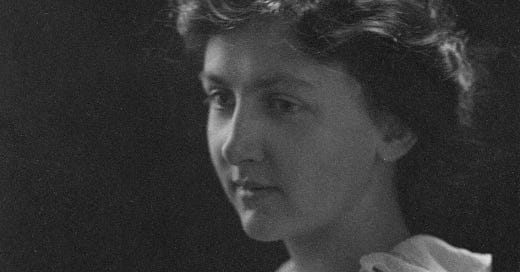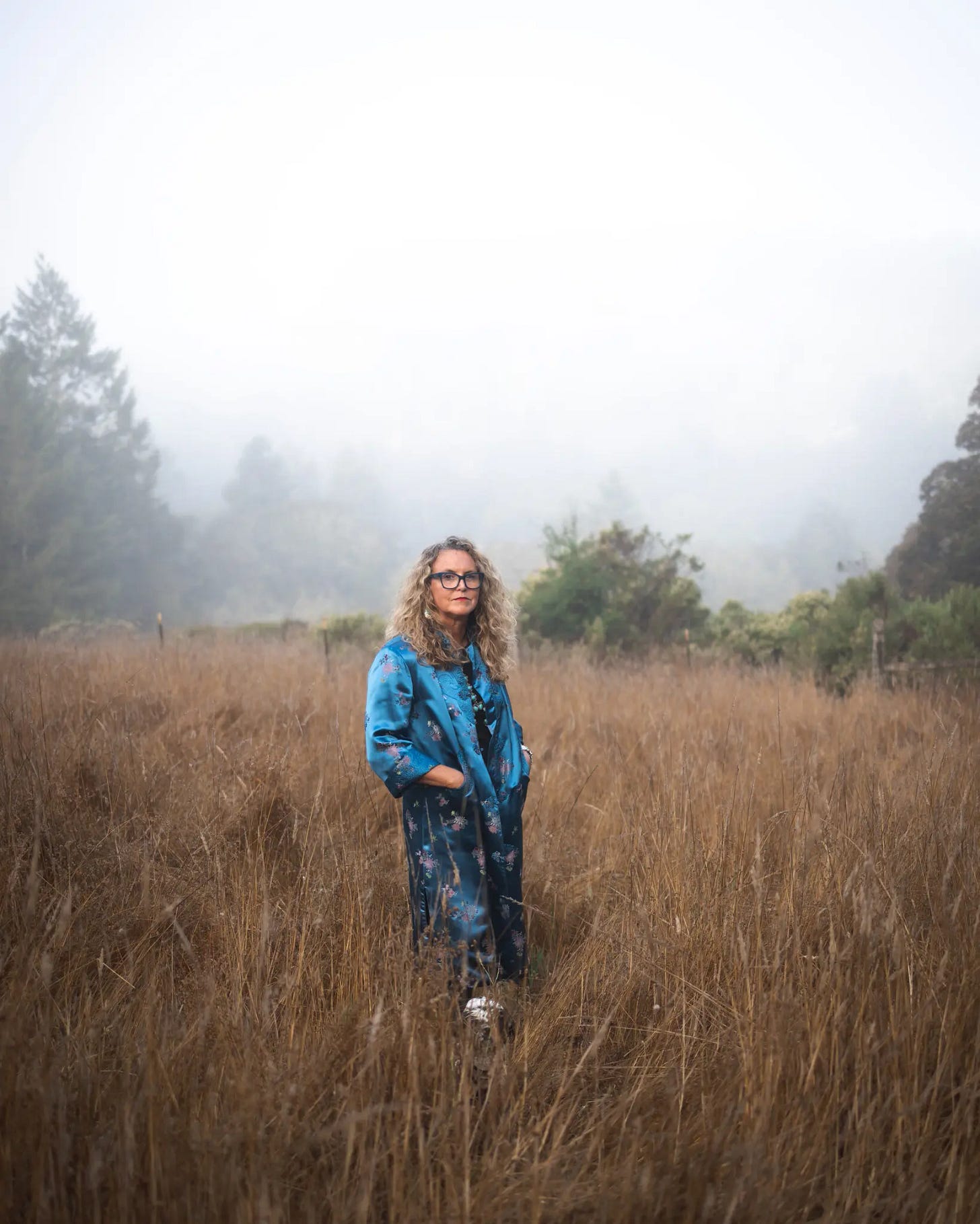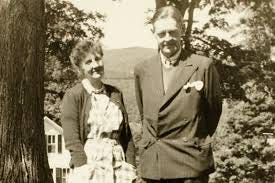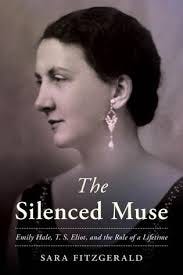Finding Lost Voices: Emily Hale, the Woman Who Inspired T.S. Eliot
A weekly email that brings back the voices of those who have been forgotten or misremembered
This week has felt a bit like a dream-like sequence. My book, Riding Like the Wind: The Life of Sanora Babb, launched on Tuesday, and I got to celebrate the launch with The
podcast, who joined me in conversation at Vromen’s Books in Pasadena, CA. (Don’t miss their latest episode where we talk about Babb’s Dust Bowl novel, Whose Names Are Unknown.) And Friday morning, I woke up to an article about my book in the New York Times. Anyone who works in the area I work in — bringing back lost voices — knows one does not have many weeks like this! So, I just want to share my utter joy with you. Joy, thanks to articles like the ones in the Atlantic and the New York Times, more people will know more about Sanora Babb now. (You can read an excerpt from my book here on Salon.)But today, I want to turn back to the purpose of this weekly newsletter: to bring back the voices of women who have been forgotten or misremembered. Welcome to all of the new members who have joined this week! If you feel inclined, please sign up for the paid subscription. This funding goes directly toward my research. If you sign up for a paid yearly subscription this week you’ll receive a free, signed copy of my latest book.
Today, I’d like to bring back the voice of Emily Hale (1891 - 1969), an American actress and teacher who was the longtime muse and confidante of T.S. Eliot. Her voice was silenced because Eliot arranged to have nearly all of her letters to him burned and insisted she seal the letters he wrote to her (which she donated to Princeton) for 50 years after her death after he married his much younger secretary, Esmé Valerie Fletcher, in 1957.
On January 2, 2020, those 1,131 sealed letters held at Princeton University Library Special Collections were finally opened, and six people were waiting at the door to read them. Two of them, Lyndall Gordon and Sara Fitzgerald, would go on to write important books about Hale that have come out recently. Gordon and Fitzgerald wanted to be the first to discover who the mysterious Emily Hale was–the woman who inspired T.S. Eliot as he wrote his famous poems. She had been hinted about in T.S. Eliot scholarship up to that point. But, until that day, no one knew the full truth about her.
Frances Dickey chronicled the opening of the letters in Reports from the Emily Hale Archive, which were “live” posted on The International T. S. Eliot Society website. As Frances Dickey later states in the article “May the Record Speak: The Correspondence of T. S. Eliot and Emily Hale,” in the letters Eliot “reveals a trove of personal information of the kind that he successfully withheld during his life. . . . Eliot’s letters to Hale will reshape our understanding of the poet and the literary era that bears his impress.”
Indeed, we discover in all that has been written about the letters that the correspondence Hale saved between Eliot and herself has forever changed the narrative that Eliot so carefully crafted. Eliot wrote more letters to Hale “than he had written to anyone else.” In these letters, Eliot reveals the confessional nature of his poems, such as how Hale was the “hyacinth girl” in “The Waste Land” and “A Rose of Memory” in The Four Quartets. Gordan tells us in her introduction that “to read Eliot’s letters to Emily during the thirties and early forties is to enter poems in the making.” Gordon further explained in an interview with PBS News that what she found in the letters far exceeded her expectations. "Eliot was very emotional and very explicit about how much he loved her and how important she was to his work….Eliot lays it all bare. That's striking, in part, because for a long time, it was 'unfashionable' to think of Eliot as a confessional poet"
In Fizgerald’s carefully crafted biography of Emily Hale, The Silenced Muse she traces the life of this previously unknown woman and brings her back to life.
Hale was born in New Jersey in 1891. Her father taught at Harvard Divinity School. Her mother (after whom Emily was named) suffered a breakdown after the death of her infant son. Hale lived at home with her father outside of Boston until he died in 1918 when she took a job as a dorm matron at Simmons University, where she had been running the drama club for two years. Soon, she became a speech instructor at Simmons, the first of many teaching positions she would hold over the years at the all-girls Concord Academy and Abbot Academy preparatory schools, Milwaukee-Downer College (1921–1929), Scripps College (1932–1934), and Smith College (1936–1942).
Hale and Eliot first met in 1912 when he was a graduate student studying philosophy at Harvard. By 1914, when he was leaving for Europe, Eliot declared his love for Hale; however, Hale did not feel the same way for Eliot. The two began a correspondence. Eliot wrote to Hale and sent her flowers for her theatrical performances. However, when Eliot married his first wife, Vivienne Haigh-Wood, in 1915, Hale and Eliot stopped writing to each other until 1930. Then, in 1930, his love for Hale reignited and from 1930 until 1956, Eliot wrote over a thousand letters to Hale. He visited her in California. And they spent summers together from 1935-1939 in Campden, Gloucestershire. But while he pursued Hale, Eliot told her he could not divorce his wife due to the laws of his Anglican faith. Eliot told Hale that his poem, “Burnt Norton,” was a love poem to her.
But World War II kept the two apart until 1946. When Eliot’s first wife, Vivienne, died in 1947, Eliot arranged a meeting with Hale. Eliot had long told Hale that he would marry her if he could, but instead of asking her to marry him at the meeting, he merely said he could no longer marry her. Hale was shocked and saddened. Their letters continued after this but were far less frequent.
Hale continued her teaching life until she retired from Abbot Academy in 1957. The same year that Eliot married his young secretary. Many Eliot scholars have implied that at this time Hale was hospitalized due to a nervous breakdown, but no evidence of this breakdown is cited. In her new biography, Sara Fitzgerald reinforces the questioning of this narrative, "Emily Hale is painted as someone who fell apart, who had a nervous breakdown after loving Eliot for so many years and seeing him marry another woman", but "I didn't necessarily find that to be the case. I felt she got over this blow and kept living." Hale would go on to continue her acting career in a number of well-received community theater productions.
The story of Eliot’s autobiography is a story of archival violence whereby Eliot tried to curate the image of himself he wanted to be remembered. Toward the end of his life, Eliot asked Hale to destroy his letters to her. Then, when she refused and told him she was donating them to Princeton, he requested that the letters remain sealed for as long as possible. When Hale wrote to Eliot near the end of his life, asking him what he would do with her letters to him (which he once had said he would donate to the Bodleian Library at Oxford), he never answered. Instead, Eliot enlisted a colleague to burn all of them for him. As the person in power, Eliot hoped that by burning Hale’s letters to him and extending the time before the letters he’d written to her would be unsealed he could control what would be remembered about him and his poetry. He presented himself as an unemotional poet and did not think his authority over his poems would ever be questioned. He also assumed that when the world learned about the truth behind his poetics, it would do little to shake the bedrock of his reputation. The letters completely dismantle this self-imposed image.
In the epilogue of her biography, Gordon recounts the moment when she and Frances Dickey sat at the long table in the Princeton library and read the first proof that Emily Hale was the hyacinth girl in “The Waste Land.” In his second letter to her, Eliot asks Hale to compare the “Hyacinth girl” passage and “My friend, blood shaking my heart” in The Waste Land with “Pipit” in Ash Wednesday so that she could see how his love for her had developed between the writing of these poems. The letter ends with Eliot’s declaration that he will always write for Hale. Gordan tells us that when she and Dickey “read that extraordinary letter for the first time we jumped up to hug.” Their elation was derived from the fact that the letter confirmed what they had long argued: that Hale was the most important female figure in Eliot’s life. A point which had always provoked “annoyed reviews from men who put Hale in her place as a female of no importance.” Gordan’s Eliot’s New Life (1988) was the first scholarly text to posit Hale’s significance to Eliot—claims that were dismissed by many scholars due to the fact that there were no letters between Eliot and Hale. It’s not surprising that it was the female scholars who could see the cracks in Eliot’s bedrock and could look through the narrative that had been entirely accepted by their male colleagues toward other possible stories.
While I was a student at New York University in the 1990s, I was taught a great deal of Eliot, and great pains were made to separate his reserved poetic style as being different and more elevated than those who were called the emotive and feminine confessional poets (whom I was drawn to), like Sylvia Plath, Anne Sexton, and Adrienne Rich. How satisfying it would be now to visit that classroom again, as a ghost from the future, and bring this knowledge back to my young, unsuspecting self and to my smug male teacher, who fully believed the mythology Eliot had woven about himself. To un-erase Emily Hale’s voice is to better understand Eliot, but it is also an empowering act of biography where Eliot can no longer block our full view of him.
Articles
Correcting for the Male Gaze: On the Unique Challenges of Writing Biographies of Women —LitHub
8 Biographies That Will Upend Your Perception of Famous Writers — Electric Lit
Upcoming Events
October 23 - 5:30 PM - Iris Jamahl Dunkle reads at Readers’ Books 130 East Napa Street, Sonoma, CA
October 26 -10:00 AM - 3:30 PM Creative Writing Retreat at Dominican University
Sign up to take the workshop, “Mini Biography as an Act of Revolution, a creative nonfiction workshop with Iris Jamahl Dunkle” and attend my keynote talk, “Taking Back History, One Story at a Time: Why I Write About Forgotten Women's Lives”
October 30 - 7:00 PM - Iris Jamahl Dunkle in conversation with Harry Stecopoulos at Prairie Lights Bookstore, Iowa City, IA
November
November 1 - 6:00 PM 7:30 PM - Catamaran Lit Chat with Iris Jamahl Dunkle - Catamaran Literary Reader - 1050 River St., Studio 118 Santa Cruz, CA 95060
November 7, Oklahoma Center for the Humanities, Tulsa, OK
November 13 - Book Club at Pasadena Heritage
November 18 - The Book Club of California
November 19, 4:30 PM UC Davis Manetti Shrem Museum in conversation with Matthew Stratton
November 20, 5:00 PM UC Berkeley, English Department (Room 300)
November 22 -23, University of Oklahoma in Norman, OK and Author Talk at Full Circle Bookstore, Oklahoma City. OK
December
December 1, 2:00 PM - Iris Jamahl Dunkle in Conversation with Kristen Hanlon at the Alameda Library, Alameda, CA
January 2025
January 24 - Case Western Reserve University, Cleveland, OH
January 25 - Reading with Jan Beatty at White Whale Books in Pittsburgh, PA
January 27 - Iris Jamahl Dunkle in Conversation with Donovan Hohn at Literati in Ann Arbor, MI
January 28 - Iris Jamahl Dunkle at Morgenstern Books, Bloomington, Indiana
February
February 21, Iris Jamahl Dunkle’s talk at New York University, New York, NY
February 26, 6:00 PM Iris Jamahl Dunkle reads at King's English, Salt Lake City, UT
February 27 - Iris Jamahl Dunkle reads at American West Center, Salt Lake City, UT
March
March 5 - The Bill Lane Center for the American West: Stanford, CA
March 13- 5:00 PM Garden City Community College, Kansas
March 14 - 17 Books and Books in Coral Gables, FL and Key West, FL (Exact date TBA)
March 21 - 2:00 PM New York Public Library, New York City
May
May 17 - 5:30 - 7:30 National Steinbeck Center, Salinas, CA










I read The Hyacinth Girl this year after I became fascinated with the writing of Vivienne Eliot, without whom (and Ezra Pound) I wonder if Eliot would have amounted to much in the literary world. Sara Hale's theatre and artistic life really amazed me. It was a life I never really imaged a single woman living in that time. I am glad to know Eliot couldn't dismiss such an important person in his poetic development forever. He owed her and Vivienne rather a lot💔and he just gobbled them up and threw them away.